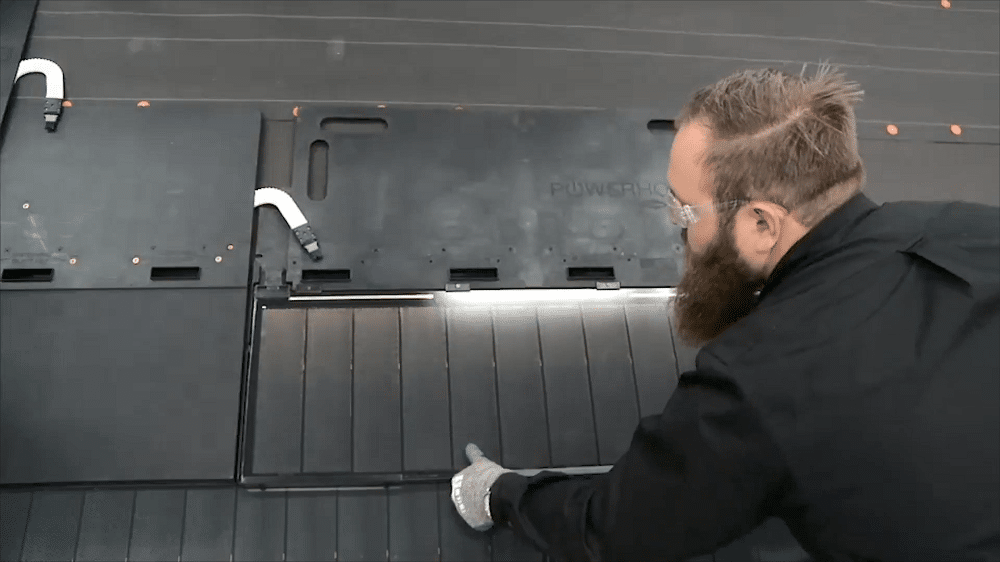We’ve been on this roof before – our hearts were broken here. A fresh suitor has emerged, however he has some factories to build first. Then wild news appeared – and it brings interesting thoughts and new opportunities. And now – the one we once longed for has come back – with a vengeance. I’m a fool, I’ll fall for a pretty face twice.
RGS Energy has released a pre-UL Certification DRAFT specification page (PDF) of its Powerhouse 3.0 Solar Shingle PH-055 and PH-060. The document was originally uploaded on June 7, and was updated last week.

The most exciting piece of data in this document is the 15.6% and 17.1% efficiency of the “exposed area” of the solar shingle. This area is about 3.8 square feet of space – about one quarter the space of a standard solar panel. There is a slightly larger area above the exposed solar shingle that is covered by another interconnected series of solar shingles, or the first row of standard roofing shingles. This covered area is not included in the efficiency calculation.

The solar shingle will use 24 half cut monocrystalline PERC solar cells. They will be arranged in two rows of twelve. There is one bypass diode. Risen Energy will manufacture and supply the solar cells.
The prior generation of the Powerhouse Solar Shingle, the PH 2.0-43, used Copper Indium Gallium di-Selenide (CIGS) thin film solar cells. Those shingles peaked at 43 watts – an efficiency of 12.3% in a very similar format.
The company’s pricing documentation listed the hardware at $2.80/W – with balance of system costs at $0.25/W and install labor at $0.25/W, totalling $3.30/W. The documentation suggests the solar shingle offsets an equivalent roofing value of $0.44/W – meaning an effective price of $2.86/W installed for a 6 kW residential solar power system, versus a national average of $3.73/W per an EnergySage report, which is higher than other estimates.

Tomorrow Lives
RGS Energy has taken the Powerhouse Solar Shingle from a prior thin-film format into the hottest solar cell technology we’ve got going on today, and it makes all the difference. There is no longer a trade-off to gain the aesthetics that American home owners have steadfastly stuck to.

A group of researchers in the Netherlands saw three segment of buyers arise (above) – aesthetics first (Segment 1), picky – but not specific (Segment 2), and those who equally aim for service+product quality (Segment 3), with a respectable payback period.
Consumers of Segment 1 experience a significant need for aesthetics. The willingness to choose solar panels will be more positive if there is a high aesthetic option. In segment two and three the importance of aesthetics is viewed as a less important feature, but when giving the possibility, consumers choose for the more aesthetic option.
Segment 1 – 40% of the study – appears to represent the largest population of American buyers and is probably the reason so many U.S.-based manufacturers have focused on good looking (read: black frame, black mono solar cells and black backsheet) solar panels versus the cheaper standards of higher efficiency, white backsheet, and silver aluminum frames.

Image: Solartech Universal
RGS Energy has rejoined the table with a compelling product and a respectable price, just in time for an explosion of building integrated photovoltaic (BIPV) installations on new homes in California. Forgive me if you catch me swooning.
This content is protected by copyright and may not be reused. If you want to cooperate with us and would like to reuse some of our content, please contact: editors@pv-magazine.com.








I would like to see someone compare and list the ten too solar systems/installers on three different homes starting with a floor size of 1,200 square feet.
Give real world costs that the “uninformed” consumer.
Yes, I’m lazy doing interpolations.. However, I feel if bottom line costs are calculated (realizing none can be exact) and be within a few hundred dollars plus or minus, MORE people would install more panel solar with a power wall, or reroof with solar shingles. More seniors would immediately sign up, because they now understand AND budget for a viable system. Consider please, both panels AND shingles. Many thanks..Richard
I am so n let me for a Tesla shingle roof. I’m not good at the math and techno talk. Are you saying your shingles are equal to those of TESLA and will cost less overall for consumers?
I am currently in line for a Tesla shingle roof. I’m not good at the math and technical talk. Are you saying your shingles are equal to those of TESLA and will cost less overall for consumers? Do you also have a powercell?
They will cost considerably less. RGS features Sonnen batteries.
How do these shingles operate, please? Inverters? Optimizers? Central inverter?
The efficiency numbers are very misleading. The whole problem with BIPV is that you have no cooling space below the PV so the cells get much hotter which drastically reduces efficiency. Moving to silicon from thin film will increase those losses quite a bit. What’s really disappointing is the aesthetics: they really aren’t integrated at all. It’s silicon cells surrounded by conventional asphalt which looks just like another flush mount system, but without any of the advantages.
If you want to see a whole new fresh approach have a look at http://www.solarmassenergy.com, by far the best aesthetics, and power output. They are specially designed to reduce power loss due to heat. This product has been installed on 3 continents. Its so discrete you may of walked passed an installation without knowing it was even solar.
Very cost effective, easy to install.
And available in slate grey and terracotta.
Solarmass are about to launch both a slate version and a super lightweight version.
Installations on Grade 1 listed buildings in London, National parks, Garages and out buildings, small homes to mansions across the world.